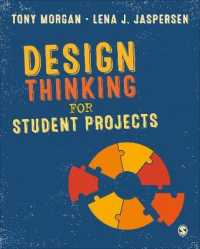- ホーム
- > 洋書
- > 英文書
- > Nature / Ecology
Full Description
Accelerating urbanization worldwide means more urban-centered disasters. Floods, earthquakes, storms and conflicts affecting densely populated areas produce significant losses in lives, livelihoods and the built environment, especially in comparison to rural areas. Poor urban dwellers, almost always the most vulnerable, too often bear the brunt. Aid agencies and urban professionals have been slowly adapting to these new conditions, but older models and practices hinder the most effective engagements.
Drawing directly from the experiences of urban disasters in the Philippines, Chile, India, Thailand, Iraq, Haiti and Nepal, among other countries, Urban Disaster Resilience brings to light new collaborations and techniques for addressing the challenges of urban disasters in the coming years. Chapters range from country-specific case studies to more synthetic frameworks in order to promote innovative thinking and practical solutions.
Edited by David Sanderson, Jerold S. Kayden and Julia Leis, this book is a crucial read for humanitarian and disaster specialists, urban planners and designers, architects, landscape architects, housing and economic development professionals, real estate developers, private business managers and students interested in the subject, whether based in non-governmental organizations, local, state or national governments, international agencies, private firms, or the academy.
Contents
Introduction Part I. Urban planning, design and cities 1. Designing resilient cities and neighborhoods 2. Reconstructing the city: the potential gains of using urban planning and design practices in recovery and why they are so difficult to achieve 3. Fables from the reconstruction: lessons from Chile's recovery after the 2010 earthquake and tsunami 4. Risk, resilience and the fragile city Part II. People, places, complex systems and regulation 5. Urban disaster resilience: learning from the 2011 Bangkok, Thailand, flood using morphology and complex adaptive systems 6. Regulatory barriers and the provision of shelter in post-disaster situations: housing, land and property (HLP) issues in the recovery of Tacloban, the Philippines, after Typhoon Haiyan 7. How does reconstruction after disaster affect long-term resilience? 8. Conflict and urban displacement: the impact on Kurdish place-identity in Erbil, Iraq Part III. Urban markets, micro-enterprise, insurance and technology 9. Linking response, recovery and resilience to markets in humanitarian action 10. Petty trade and the private sector in urban reconstruction: learning from Haiti's post-earthquake Iron Market 11. Using disaster insurance to build urban resilience: lessons from micro-enterprise in India 12. 'Humanitarian hybrids': new technologies and humanitarian resilience Epilogue Reflections on the practice of disaster resilience








